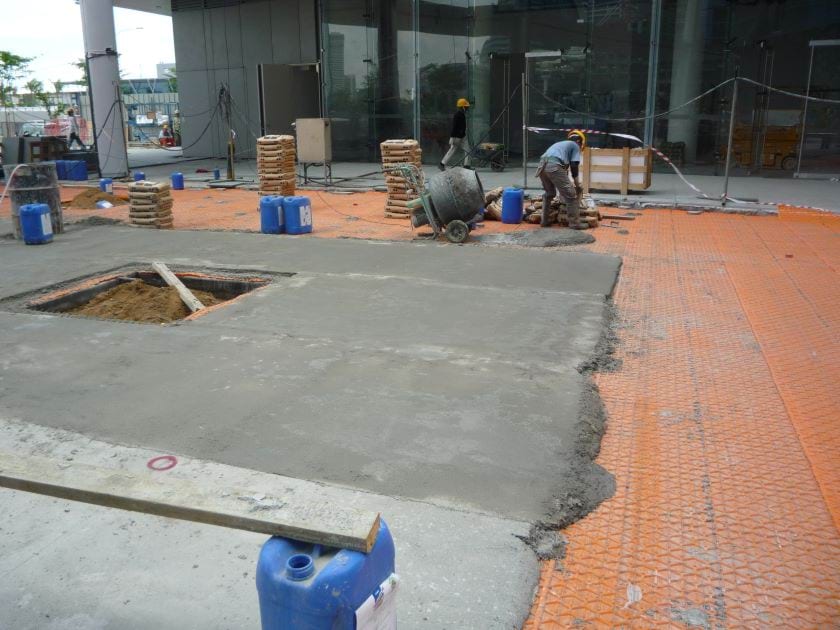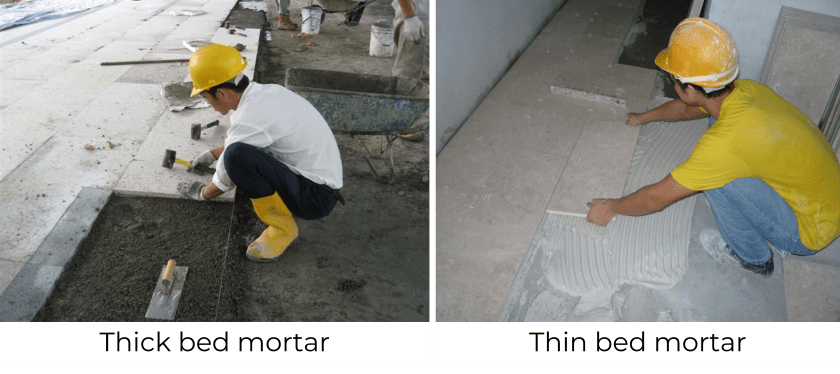The purpose of a screed is to give a smooth and level floor surface on which to lay your chosen floor finish that could be vinyl, tiles, natural stone, carpet, parquet, wood and so on.
There are two types of screeds - Bonded and Unbonded.
Screeds are typically bonded onto most concrete surfaces at the construction sites. Screed mortars comprise of the normal Portland cement and sand mix which requires a minimum thickness of 20mm. A slurry mix of Portland cement and latex admixture is first applied onto the surface followed by the screed mortar and laying the screed mortar onto the slurry while it is still wet (How to apply floor screeds and wall render).
Unbonded screeds are used for special situations where the floor finish needs to be separated from the structure, for instance, when there is intense movement on the structure or substrate, when there is rising damp from the ground, cracks to the substrate or when cement mortars cannot bond to the receiving surface (for example: insulation panel for inverted roof system, drain mat, etc.).
Unbonded screeds are not laid directly on the substrate, instead there is a separation layer which can be in the form of polyethelene, drain mat, or bitumen waterproofing products, etc. The unbonded screed itself must be at least 40mm thick regardless of mortar type. When screed thicknesses are more than 40mm, steel reinforcement mesh should be inserted.

There are two types of mortar bedding application for tiling works – the Thin-bed mortar and Thick-bed mortar. Typically, most sites adopt the thin-bed mortar method where tiles are laid over a cured screed. This is carried out in two operations.
Tiles can also be laid onto concrete surfaces with the thin-bed method. However, when surfaces/ substrates are not accurate or out of plumb to receive tiling by the thin bed method, screed application is still necessary to level the surface to achieve the required substrate accuracy. It is not advisable to apply a very thick layer of tile adhesive to level the uneven surface.
Screeds should be allowed to harden and cure properly. During the curing stage (typically 7 days for every 10mm thickness), hygrometric shrinkage may take place and mortar is also allowed to dry out to achieve a low percentage of residual moisture content. If there is lack of time on site for quick turnaround operations, one option is to use a rapid-drying screed mortar such as Mapei’s Topcem Pronto.

Thick-bed application is the traditional method of laying tiles with cement mortar. This method of laying does not use tile adhesive. When laying natural stones and pavers with uneven thicknesses, contractors may sometimes adopt the thick-bed method for the installation. Pavers and stones for driveways and pavements are sometimes installed with this method. To lay the thick bed mortar, a slurry coat is first applied to the concrete surface, followed by laying the thick-bed mortar with a minimum thickness of 20mm, applied while the slurry coat is still fresh. Another slurry coat is then applied to the mortar surface and then immediately lay the tiles and stone and tamped to compaction. Allow the installation to cure properly before opening the floor for operational use.
____
About Mapei:
Founded in Milan since 1937, Mapei is today a world leading producer of adhesives and complementary products for the laying of all types of floor, wall and coating materials. Mapei’s specialty lies in products for ceramics and stone materials, among other product lines. Mapei’s adhesives for tiles and stones are certified according to international standards and are SGBC certified. Experience proven by numerous notable projects worldwide.


December 9, 2021. 5:57 AM
November 9, 2020. 2:20 AM
March 17, 2021. 10:04 AM
September 11, 2020. 8:59 AM
